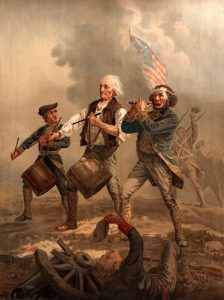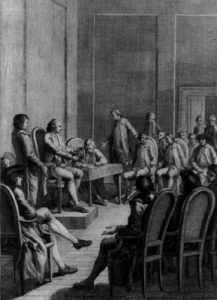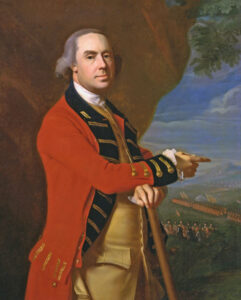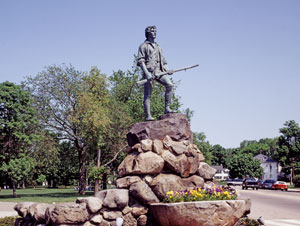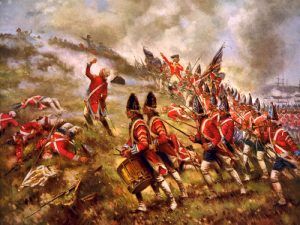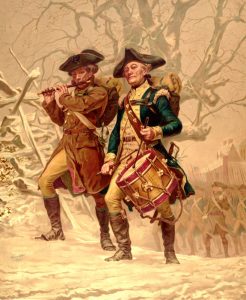The American Revolution occurred fundamentally because, by 1763, the English-speaking communities on the far side of the Atlantic Ocean had matured to the extent that their interests and goals were distinct from those of the ruling classes in the mother country. British statesmen failed to understand or adjust to the situation. Ironically enough, the British victory in the Seven Years’ War set the stage for the revolt. It freed the colonists from the need for British protection against a French threat on their frontiers and gave free play to the forces working for separation.
In 1763, the British government, reasonably from its point of view, moved to tighten the empire’s control system and force the colonists to contribute to imperial defense. As part of an effort to make the costs of the empire be borne by all British subjects, his Majesty’s government sought to create an “American Establishment,” a force of 10,000 regular British soldiers in North America. Taxes would pay for the cost of this military force the British Parliament levied on Americans. This imperial defense plan touched off the long controversy about Parliament’s right to tax that started with the Stamp and Sugar Acts and led to a final provocative deed in December 1773 at the “Boston Tea Party.” This party destroyed a cargo of East India Company tea by a patriot mob in a protest against “taxation without representation.”
In response to the Boston Tea Party, the King, and his ministers blindly pushed through Parliament a series of measures collectively known in America as the Intolerable Acts: closing the port of Boston, suspending civilian government in Massachusetts, and massing troops in Boston under the military rule of Major General Sir Thomas Gage. Outraged by the heavy-handed response to one colony, the other American political leaders called for establishing a continental congress, an American parliament, to coordinate a political drive to defend what the colonists deemed their rights and interests as Englishmen.
In 1763, the colonial leaders held that only their popular assemblies, not the British parliament, had the right to levy taxes on Americans. This had raised the specter of an arbitrary British government collecting taxes in America to support red-coated regulars who might be used not to protect the frontiers but to suppress American liberties. Placing Massachusetts under military rule gave that specter some substance and led directly to an armed revolt.
The First Continental Congress meeting in Philadelphia, Pennsylvania, on September 5, 1774, addressed respectful petitions to Parliament and the King. However, it also adopted non-importation and non-exportation agreements to coerce the British government into repealing the offending measures. Committees were formed throughout the colonies in almost every county, town, and city to enforce these agreements. In each colony, these committees soon became effective local authorities. They formed the base of a pyramid of revolutionary organizations with revolutionary assemblies, congresses, conventions, and safety committees at the top.
This loosely knit combination of de facto governments superseded the constituted authorities and established firm control over the country. This was before the British were in any position to oppose them. The de facto governments took over control of the militia and other colonial military resources such as armories and powder stores. They also identified which local militia officers could be trusted and which were known to be loyal to Britain. Where possible, the various colonies reorganized the standing militia and formed rapid response units, including the famous Minutemen, intended to turn out fully armed “in a minute’s notice.” In colonies where a British governor’s official control over the militia could not be challenged, volunteer companies began training under the guidance of veterans of the French and Indian War. As winter turned into spring in 1775, patriot leaders were busily shaping the military forces that, if the necessity arose, might oppose the British Army in the field.
Massachusetts, the seat of the crisis, led the way with military preparations. The Provincial Congress, eyeing Gage’s unprecedented armed force in Boston, directed town officials to enlist a third of their adult males as Minutemen formally. It began plans to combine local militia companies into regiments and started selecting generals to command the force. It also began collecting ammunition, artillery pieces, and other military supplies outside Gage’s immediate reach. One of the most significant depots lay at Concord, about 20 miles inland from Boston.
General Gage learned of the collection of military stores at Concord and determined to send a force of Redcoats to destroy them. His preparations were made with the utmost secrecy. Yet there were so many patriot eyes in Boston. When the British force of 700 men set out on April 18, 1775, two messengers, Paul Revere and William Dawes, preceded them to spread the alarm throughout the countryside. At dawn the next day, when the British arrived at Lexington, the halfway point to Concord, they found a body of militia drawn up on the village green. Some nervous finger — whether of a British regular or an American militiaman is unknown to this day — pressed a trigger. The impatient British regulars, apparently without clear orders from their commanding officer, fired a volley and then charged with a bayonet. The militiamen dispersed, leaving eight dead and ten wounded on the ground. The British column moved on to Concord, engaged in another unanticipated skirmish, and destroyed much of the military stores that the Americans had been unable to remove. Their return journey to Boston took a civil disturbance issue and transformed it into open warfare.
By this time, the alarm had spread far and wide, and ordinary militias and Minutemen had assembled along the British route. From behind walls, rocks, and trees, and from houses, they poured their fire into the columns of Redcoats. However, the frustrated regulars found few targets for their accustomed volleys or bayonet charges. Only the arrival of reinforcements from Gage enabled the British column to return to Boston’s safety. At day’s end, the British counted 273 casualties out of 1,800 men engaged; American casualties numbered 95 men, including the toll at Lexington. What happened was hardly attributed to the marksmanship of New England farmers — it has been estimated that 75,000 shots poured from their muskets that day — but it did testify to the stern determination of Massachusetts to resist any attempt by the British to impose their will by armed force. The spark was lit in Massachusetts and soon spread throughout the rest of the colonies. Whatever really may have happened in that misty dawn on Lexington Green, the news that speedy couriers riding horses to exhaustion carried through the colonies from New Hampshire to Georgia was of a savage, unprovoked British attack and of farmers rising in the night to protect their lives, their families, and their property.
Like Fort Sumter, Pearl Harbor, and September 11 in subsequent years, Lexington provided an emotional impulse that led all true patriots to gird themselves for battle. Militia poured in from the other New England colonies to join the Massachusetts men; they soon formed a ring around Boston. Other forces mobilized under Ethan Allen of Vermont and Benedict Arnold of Connecticut seized the British forts at Ticonderoga and Crown Point. These were strategic positions on the route between New York and Canada. These posts yielded valuable artillery and other military supplies. The Second Continental Congress, which assembled in Philadelphia on May 10, 1775, was forced to turn from embargoes and petitions to the problems of organizing, directing, and supplying a military effort.
Before Congress could assume effective control, the New England forces assembled near Boston fought another battle. After Lexington and Concord, the New England colonies implemented their military plans as they had in earlier wars with the French and Indians. They moved to replace the militia gathered before Boston with volunteer forces, constituting what might be called a New England army. Each of the four New England states raised and administered troops under its commander. As might be expected with such a loose organization, discipline was lax, and there was no unified chain of command. Though Artemas Ward, the Massachusetts commander, exercised overall control by informal agreement, it was only because the other commanders chose to cooperate with him; all decisions were made in the council. The volunteers in the Connecticut service had enlisted until December 10, 1775, and those from the other New England states until the end of the year. The men were dressed, for the most part, in homespun clothes and armed with muskets of varied types; powder and balls were short, and only the barest few had bayonets.
Late in May, Gage received limited reinforcements from England, bringing his total force to 6,500 rank and file. With the reinforcements came three major generals of reputation — Sir William Howe, Sir Henry Clinton, and Sir John Burgoyne — men destined to play significant roles in England’s loss of its American colonies. The newcomers all considered that Gage needed more elbow room and proposed to fortify Dorchester Heights, a dominant position south of Boston previously neglected by both sides. News of the upcoming move leaked to the Americans, who immediately countered by dispatching a force to the Charlestown peninsula. Other heights, Bunker Hill and Breed’s Hill overlook Boston from the north. The original intent was to fortify Bunker Hill, the eminence nearest the narrow neck of land connecting the peninsula with the mainland. Still, the working party sent out on the night of June 16, 1775, decided instead to move closer in and construct works on Breed’s Hill — a tactical blunder, for these exposed works could much more easily be cut off by a British landing on the neck in their rear.
The British scorned such a tactic, making a conscious decision to try and stop the conflict short with a psychologically crushing demonstration of brute force. However, the British generals committed a critical error, assuming that the assembled “rabble in arms” would disintegrate in the face of an attack by disciplined British regulars. On June 17, Gage ferried some 2,200 of his men under Howe over to the tip of the Charlestown peninsula under cover of Royal Navy warships. Howe then sent his troops directly against the American positions, by this time manned by perhaps an equal force. Twice the British advanced on the front and flanks of the redoubt on Breed’s Hill, and twice the Americans, holding their fire until the compact British lines were at close range, decimated the ranks of the advancing regiments and forced them to fall back and re-form. With reinforcements, Howe carried the hill on the third try, mainly because the Americans had run short of ammunition and had no bayonets. The American retreat from Breed’s Hill was orderly for inexperienced volunteers and militia, and Howe’s depleted regiments could not prevent the escape. British casualties for the day totaled a staggering 1,054, almost half the force engaged, as opposed to American losses of about 440.
The Battle of Bunker Hill has been aptly characterized as a “tale of great blunders heroically redeemed.” The American command structure violated the principle of unity of command from the start; in moving onto Breed’s Hill, the patriots exposed an invaluable part of their force in an indefensible position, violating the principles of security, mass, and maneuver. Gage and Howe, for their part, sacrificed all the advantages the American blunders gave them. They violated the principles of maneuver and surprise by attacking a fortified position from the front. Their gamble to end the rebellion with a single stroke had failed. Bunker Hill was a victory won at too steep a cost; its strategic effect was practically nil since the two armies remained in the same position they had previously held. Its consequences, however, cannot be ignored. Although frequently depicted as a force of farmers and townsmen, fresh from their fields and shops, with hardly a semblance of orthodox military organization, the New Englanders used their militia training to field forces modeled on the British. Led by officers with, in some cases, more direct combat experience than many of Gage’s, the Americans had met and fought on equal terms with a professional British Army. This astonishing feat had a sobering effect on some of the more senior British commanders, for it taught them that American resistance was not to be easily overcome; never again would British commanders lightly attempt such an assault on Americans in fortified positions. Many Americans, on the other hand, misread the battle.
Bunker Hill, Lexington, and Concord created an American myth that the citizen-soldier, aroused by patriotic emotion, is more than a match for the trained professional. This tradition was to be reflected in American military policy for generations to come.
Compiled and edited by Kathy Alexander/Legends of America, updated February 2024.
Source: Richard W. Stewart, General Editor; American Military History, Volume 1, The United States Army and the Forging of a Nation, 1775-1917, Second Edition, Center of Military History, United States Army, Washington, D.C.
Also See:

